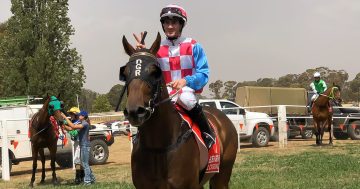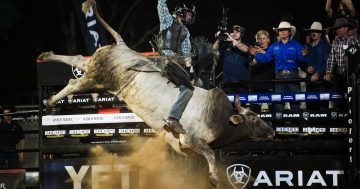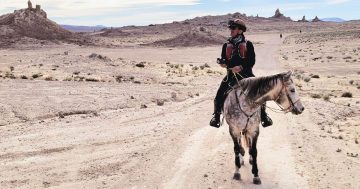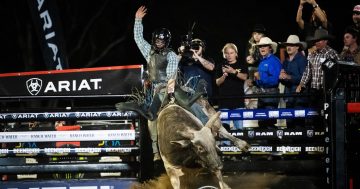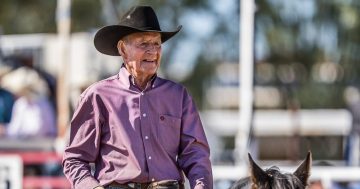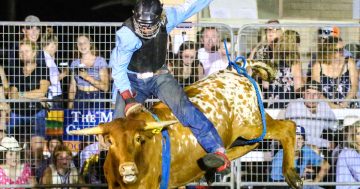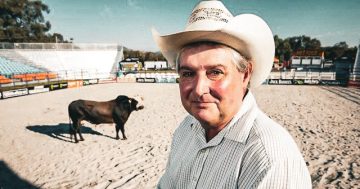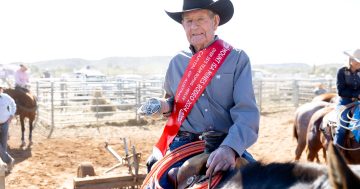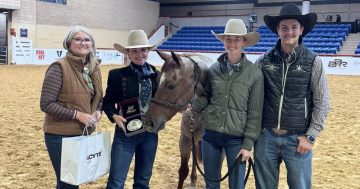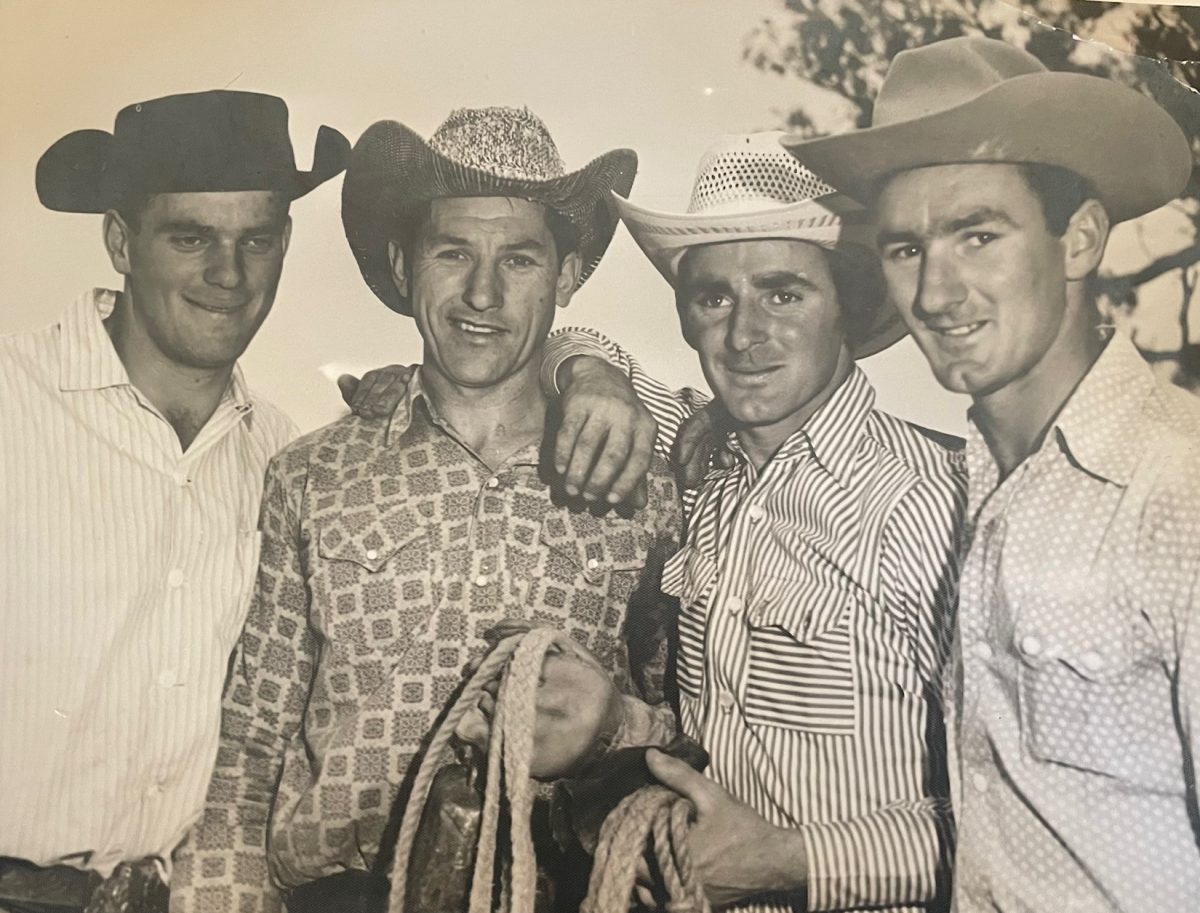
Ray and Peter Schiller (right) with Tumbarumba’s Aussie Cottam and Tumut’s Buddy Grosvenor. Photo: Ray Schiller.
In the NSW town of Young, 85-year-old Ray Schiller’s living room is filled with the gleam of trophies and the faded edges of old rodeo photographs — a lifetime of grit and triumph displayed in silver and sepia.
Decades of achievements line the walls, chronicling a career in a sport that has evolved dramatically since his prime.
Ray was born in 1939 on Marrar Station in the Riverina, one of 16 children in a farming family.
“Mum had nine kids in 10 years,” he recalls. “In all, nine boys, seven girls.”
With so many siblings, school transport was a horse-drawn spring cart with two timber planks for seating.
When the family moved to Milvale, west of Young, the children spent their days riding anything with legs — mostly horses, sometimes steers.
“We used to ride steers on the farm,” Ray says, “mainly when Dad went to town — he wouldn’t have liked it — so we waited until he was gone, then rounded them up for a ride.”
Come summer, at night, saddles and bridles were abandoned and horse manes were gripped as the boys galloped through paddocks, steering with their knees, vaulting logs and stumps. Reckless and exhilarating, it was the perfect foundation for a rodeo career.
At 12, Ray won his first event, a poddy calf ride at the Young Show. By 15, he was boarding a train to his first official rodeo in Hay with his brother Paul.
“It took forever to get there from Cootamundra,” he says. “The motor rail doubled as a mail carriage, stopping at every property siding along the tracks.”
Their debut was inauspicious: “we didn’t ride a single one. Got bucked off everything”.
But their older brother Carl had already made his mark on the local circuit, forging a reputation for skill and toughness, and the Schillers would gain notoriety as young roughriders who never backed down.
For instance, Paul was just 17 when he won the South Western Bull Riding Championship fresh out of the hospital after a bout of pneumonia.
In 1958, he barely escaped a near-fatal accident that cost him a kidney. Given 100-to-1 odds of making it through, Paul defied them, winning the bull ride at Cootamundra just five months later.
Peter, the youngest of the rodeoing brothers, started at 15. At 19, he had a breakout year, winning bull rides at Temora and Cootamundra, placing second in the Cootamundra buckjump. His aggressive riding style led to frequent injuries — concussions, facial abrasions, and a head wound requiring stitches after a bull named “Blue Terror” kicked him.
Ray Schiller was a prodigious rodeo champion. After his rocky debut, he won his first novice buckjump title at Tumut at 17. A year later, he claimed the Far Western Buckjump and Bareback Riding Championships in Condobolin. The victories kept coming — bull rides at Wagga and Crookwell, bareback wins in Jindabyne.
But rodeo had its dangers. In 1960, at Boggabilla Rodeo, Ray remembers leaving the chute — then nothing. He woke up in Goondiwindi Hospital with a fractured skull, stitches in his head, and a three-week recovery ahead.
Undeterred, the Schiller brothers — nicknamed “The Thrilling Schillers” — travelled the circuit with mates such as Cootamundra’s Bob Holder, competing from Mareeba to Victoria and Bourke to Booligal in most things the rodeo threw at them – from bucking horses, steers and cows, roping or wrestling cattle to campdrafting.
Ray’s crowning achievement came in 1968, winning the national finals bull ride and earning an engraved silver buckle — the only one among his many trophies.
“They didn’t hand out buckles much back then, lots of saddles though,” he says.
Unlike many of his competitors, Ray wasn’t a full-time rodeo rider. “I think I only competed in seven rodeos that year,” he says. “But on the day, I was the only one out of 40 riders to score on four bulls.”
He considered himself a better saddle bronc rider but prides himself on staying on more bulls than he fell off, and he still remembers two by name — ”Go Go” and “Slowdown”.
Lacking the brute strength of some competitors, Ray relied on technique. He designed and built spurs with a rolling shank for better control, an innovation inspired by an American cowboy catalogue. They impressed even Australian rodeo legend Jim McGuire, who requested a pair, as did Steve McCarthy — whose son still straps them on today.
Ray retired from rodeo in 1972 at age 32 but remained deeply involved with horses. He turned to breeding and showing quarter horses, competing at a national level.
His wife, Betty, and their sons Warwick, Andrew, and Stephen became part of the legacy, excelling in Western performance events — western pleasure, western riding, working cow horse.
“We probably had more success showing horses than I did in rodeo,” Ray admits.
“It’s a different kind of riding, but it all comes from the same place,” he says. “It’s about understanding the horse and working together.”
The pinnacle of their success was Radoo, a quarter horse now immortalised in the Australian Quarter Horse Hall of Fame. More than just a champion, Radoo was part of the family. Just as Ray and his brothers rode bareback and bridleless in their youth, his sons would hop on Radoo and execute flawless reining runs after a long day in the show ring.
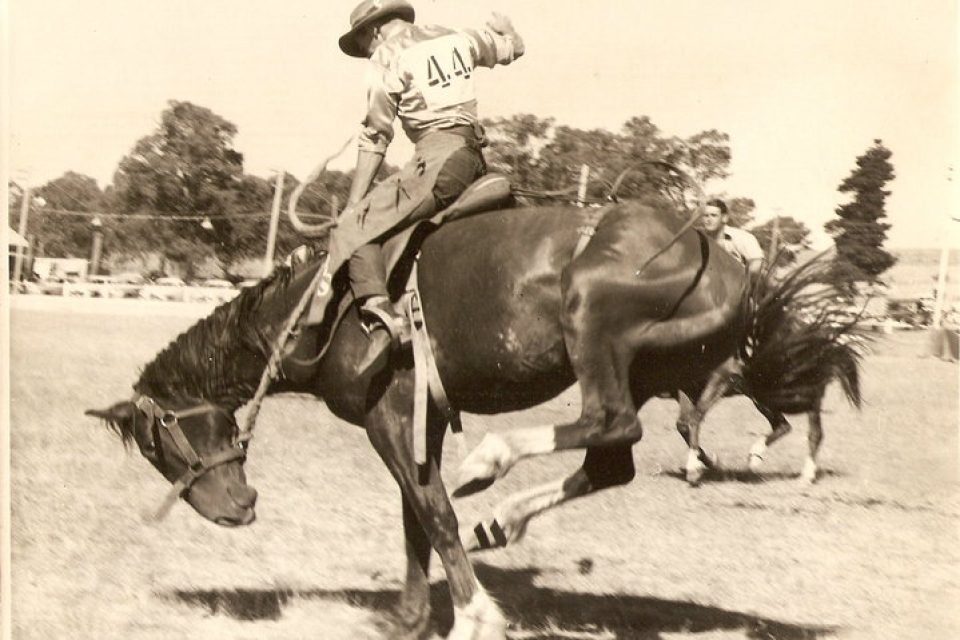
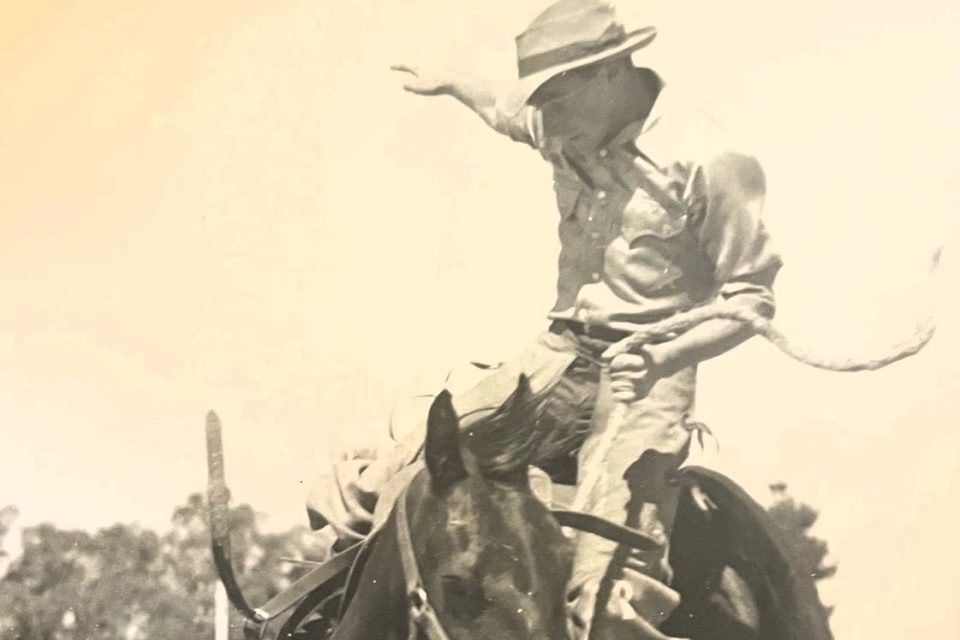
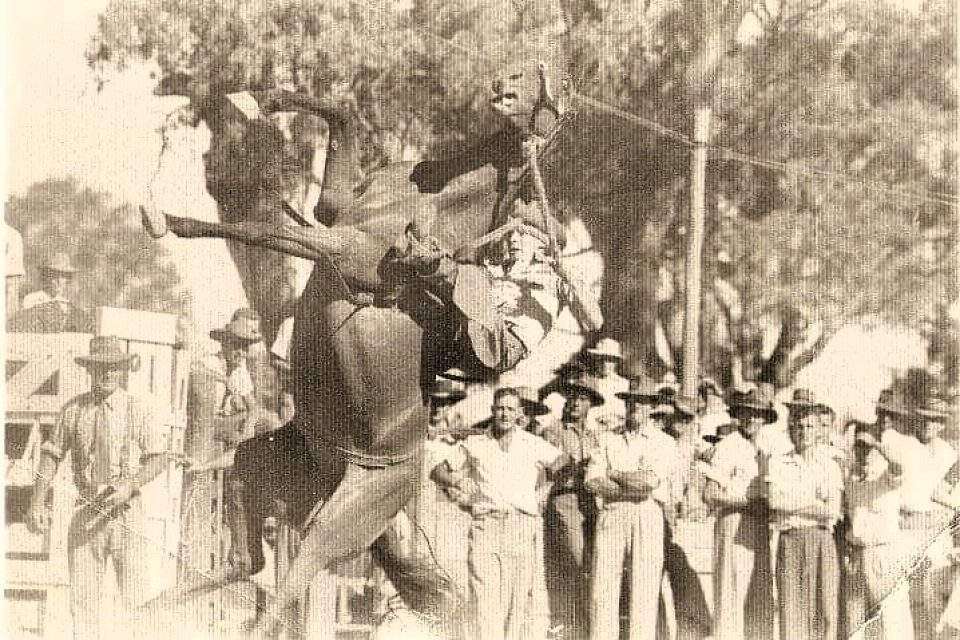
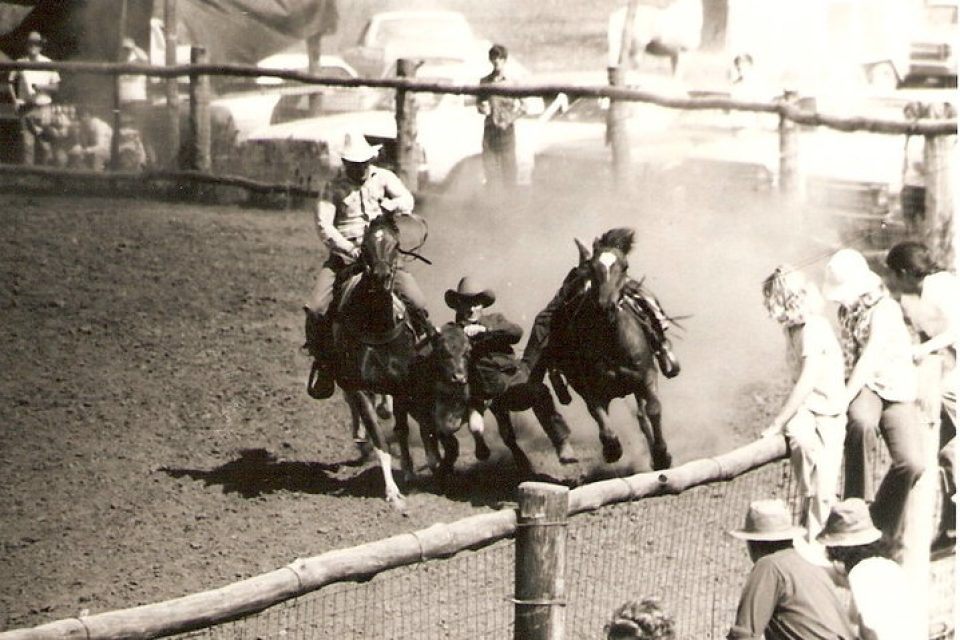
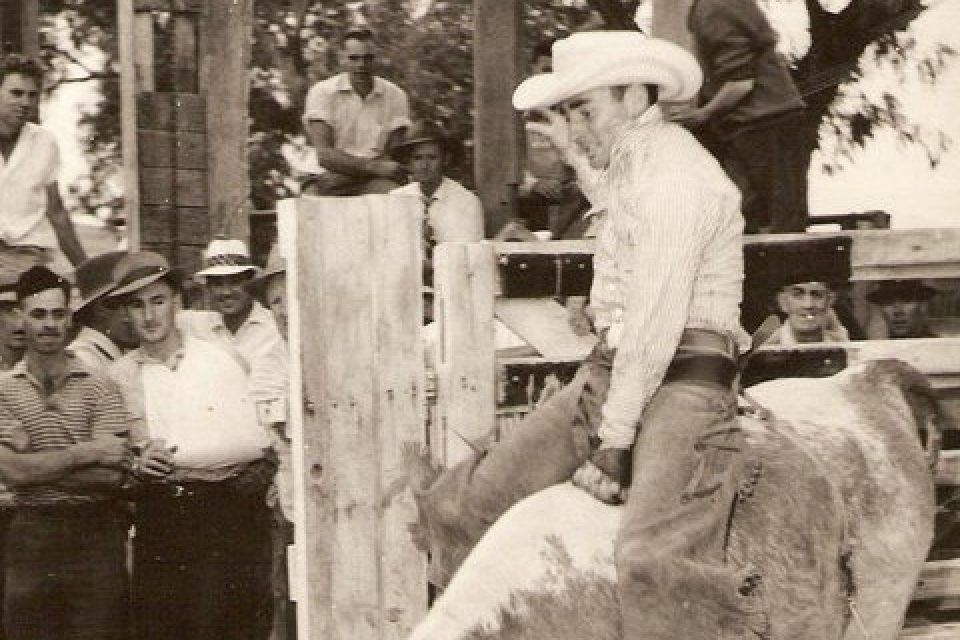
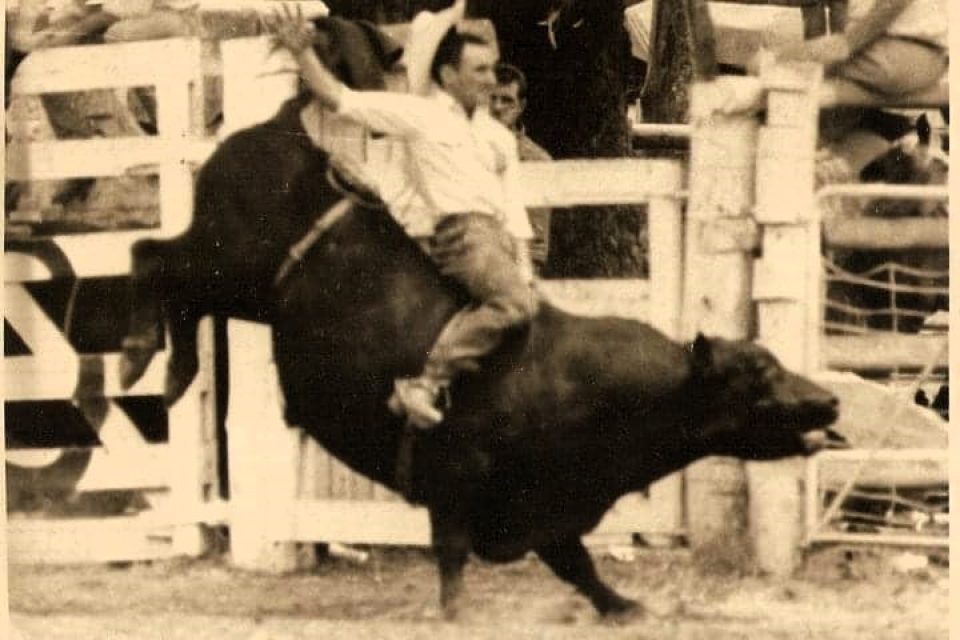
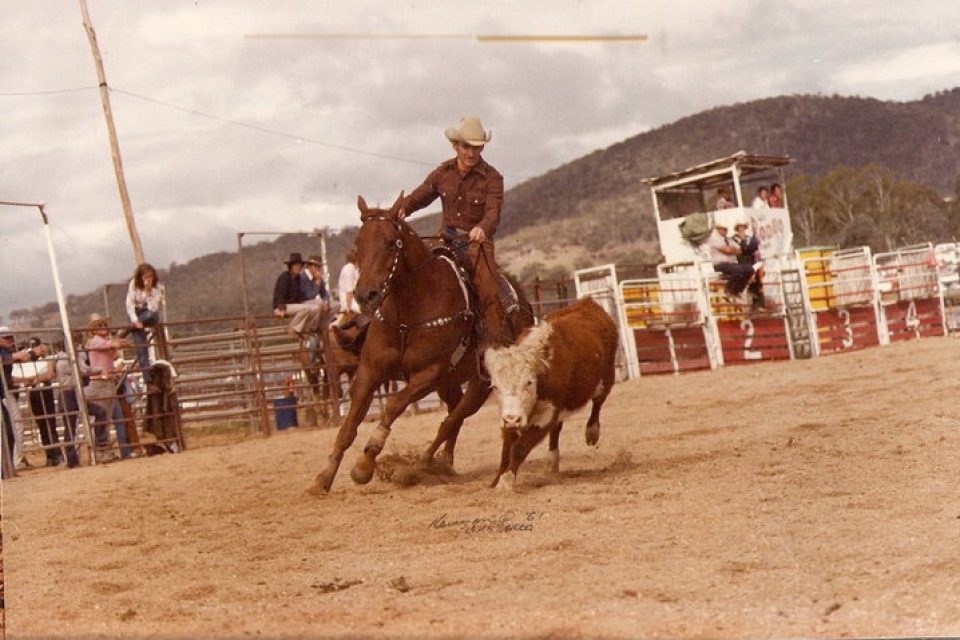
His advice for aspiring riders? “If you want to do it, do it. Don’t let anyone talk you out of it. Today, you can learn from the best.”
Ray and Betty’s photo albums are crammed with memories. One poignant image shows Ray with his brother Tony, who was tragically killed in a car accident returning from a rodeo.
But the trophies scattered throughout their home tell a story of a family inextricably woven into Australia’s rodeo and Western riding history.
“I did it for the thrill of it,” Ray says, reflecting. “Like going to a footy game — you just love it. We all did.”
That love of the sport shaped generations. Through his horsemanship, his innovations, and his unwavering dedication, Ray Schiller has left an enduring mark on Australian rodeo — and on the riders who followed in his tracks.
Like his father before him, Warwick Schiller carried on the family legacy, taking it to new heights as an internationally renowned horse trainer and clinician.
Specialising in performance horse training and behavioral problem-solving, Warwick credits Ray as a major influence in his journey.
Through his online training platform, clinics, and educational programs, he has built a global following.
His philosophy — focusing on understanding and working in harmony with horses — has shaped riders worldwide, firmly establishing the Schiller name as a cornerstone of both Australian and international horsemanship.
* With thanks to R.M.Williams Publishing for details gleaned from article titled “Wild Horses and The Men Who Ride Them – The Schiller Brothers”, Hoofs and Horns Magazine, February 1961







